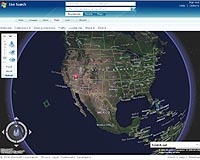 |
Washington DC (SPX) May 11, 2009 NOAA and NASA officials announced Lockheed Martin Space Systems Co. Has been selected to build two satellites for NOAA's next generation geostationary satellite series, GOES-R. The new series, poised to begin launching in 2015, will double the clarity of today's satellite imagery and provide more than 20 times the information. A previous contract award was re-evaluated by NASA and, as a result of that process, a series of corrective actions were implemented. Following that re-evaluation Lockheed Martin Space Systems was selected as the contractor. The basic contract is for two satellites with options for two additional satellites. The total estimated value of the basic contract, including the options, is $1.09 billion. Officials said a separate contract to build the GOES-R ground system will be announced later this year. "GOES-R will be a dramatic improvement compared to what we're using today - both in terms of better imagery and better data these satellites will offer," said Jane Lubchenco, PhD, under secretary of commerce for oceans and atmosphere and NOAA administrator. "The American public will see real, life-saving benefits from this advanced satellite system that will give forecasters better and more detailed information." GOES-R will improve the monitoring of sea-surface temperatures and provide more data to NOAA's hurricane forecasters, giving them sharper images of storms every 30 seconds, instead of every 7.5 minutes which the current geostationary satellites provide. "The GOES-R program is well positioned for success and is being managed through a strong, productive partnership with NASA," said Mary Kizca, assistant administrator for NOAA's Satellite and Information Service. George Morrow, director of Flight Project for NASA's Goddard Space Flight Center in Greenbelt, Md., said: "NASA Goddard is excited to be NOAA's partner in this next generation GOES development. We look forward to delivering an outstanding observatory for their operational use." GOES-R will feature the first-ever, space-based detection system for lightning activity over land and water. The new satellites also are expected to bring other key benefits, including data that will improve warnings for heat stress and bolster forecasts for unhealthy air quality, and advanced solar-monitoring instruments for space weather forecasts and warnings of solar storms. NOAA funds, manages and will operate the GOES-R program. NASA's Goddard Space Flight Center oversees the acquisition of the GOES-R spacecraft and instruments for NOAA. NOAA understands and predicts changes in the Earth's environment, from the depths of the ocean to the surface of the sun, and conserves and manages our coastal and marine resources. Share This Article With Planet Earth
Related Links NOAA Earth Observation News - Suppiliers, Technology and Application
 Virtual Earth gets 3D Photosynth views
Virtual Earth gets 3D Photosynth viewsSan Francisco (AFP) May 7, 2009 Microsoft on Thursday enhanced its Virtual Earth online mapping service with Photosynth technology that melds pictures to create 3D views of places and spaces. The move allows businesses or government agencies to provide virtual tours of locations displayed online with 360-degree views. "The integration of Photosynth into Virtual Earth marks an important step in enabling businesses to us ... read more |
|
| The content herein, unless otherwise known to be public domain, are Copyright 1995-2009 - SpaceDaily. AFP and UPI Wire Stories are copyright Agence France-Presse and United Press International. ESA Portal Reports are copyright European Space Agency. All NASA sourced material is public domain. Additional copyrights may apply in whole or part to other bona fide parties. Advertising does not imply endorsement,agreement or approval of any opinions, statements or information provided by SpaceDaily on any Web page published or hosted by SpaceDaily. Privacy Statement |